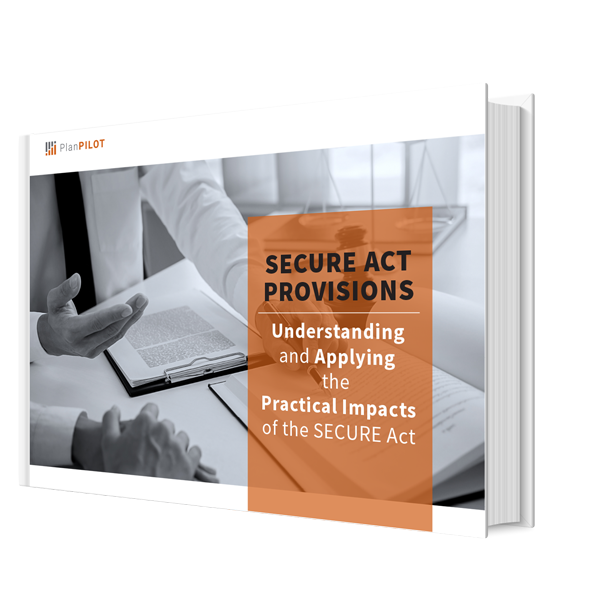Although U.S. stock indexes are hovering at or near all-time highs, many American workers still aren’t financially secure enough to retire. In response, the Setting Every Community Up for Retirement Enhancement (SECURE) Act focuses on promoting lifetime income options like annuities within a 401(k) and incentivizing businesses to expand their retirement offerings like auto enrollment. The Act also liberalizes the existence of Multiple Employer Plans (MEPs) for plan sponsors to pool their investments and plan administration usually at a cost savings.
This Act officially became law in December 2019, marking one of the most comprehensive retirement reform packages employers have seen in years. What should plan sponsors and participants know about these changes?
Plan Sponsors’ SECURE Act Obligations
Some of the SECURE Act provisions have already taken effect, while others apply only to plan years beginning in 2021. Our SECURE Act whitepaper provides a comprehensive overview of the Act’s current and future provisions.
The most immediate changes include:
- An increase in the age for required minimum distributions (RMDs) from age 70.5 to 72, as well as a provision allowing individuals over age 70.5 to continue contributing to their IRA.
- Elimination of the ability to make plan loans through a credit card.
- Expansion of pre-retirement, penalty-free distributions to include “qualified birth or adoption” expenses of up to $5,000.
- An increase in penalties associated with plan sponsors’ failure to timely file Form 5500 and required notices.
- There is also significant expansion of the safe-harbors for automatic enrollment and non-discrimination testing.
Most of these changes will require plan sponsors to amend their plan documents, although can do so subsequent to implementation. Recordkeeping and payroll systems must also be updated as soon as possible to implement these changes, and plan sponsors must be even more vigilant to timely file all necessary documents.
Unanswered Questions
While the SECURE Act’s most immediate reforms have been put into place, there remain some unanswered questions about how plan sponsors’ responsibilities will change beginning in 2021. These include, but aren’t limited to:
- The enactment of the “lifetime income stream disclosure,” which requires the plan sponsor to disclose, at least once every 12 months, the equivalent of the participant’s account balance if it was converted to a lifetime income stream. Because the U.S. Department of Labor has not yet defined the assumptions the plan sponsor must use in creating these figures, plan sponsors cannot yet include these calculations in their plan documents.
- The addition of an ERISA “safe harbor” for selecting and monitoring annuities within a retirement plan. Under these regulations, a fiduciary is not required to choose the cheapest annuity; instead, the fiduciary can compare the various features and benefits of all offerings to make the best choice for plan participants.
- Expansion of the maintenance and portability of guaranteed income options like annuities. Instead of withdrawing funds, paying taxes, and using these funds to purchase an annuity, plan participants can now obtain a direct, tax-deferred distribution of a guaranteed income investment if the plan stops offering it. However, Treasury must still finalize the various rules and regulations that must be in place before this provision takes effect.
Much like the Tax Cuts and Jobs Act, the impact of the SECURE Act will be felt by plan sponsors and participants for years. By offering pro-active, value-added services to all our clients, PlanPILOT can help your organization assess and seamlessly put these new provisions in place. Learn more about the services we offer and get in touch with one of our experienced consultants today.
|
Understanding and Applying the Practical Impacts of the SECURE Act Plan sponsors need to understand all of the new provisions. This paper reviews the new requirements for plan sponsors to follow along with many new opportunities that are now available to plan sponsors to improve their retirement programs. |


